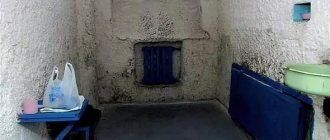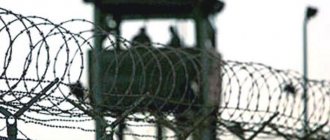Since Part 1 of Article 117 of the Penal Code of the Russian Federation looks somewhat vague due to its saturation with general phrases, penal system officers impose completely different penalties for the same type of offense.
Therefore, recently, more and more often, strict penalties are subjectively applied to prisoners and regimes are strengthened, guided not by current legislation, but by personal relationships.
Thus, the lack of specific legal grounds for placing a person in solitary confinement (in a PKT, a punishment cell, an EPKT) has resulted in a problem that requires elaboration.
What is PCT and PCT? Let's look at it in this article.
Penalty measures in places of deprivation of liberty - SUS, BUR, SHIZO, DISO and others
Places of imprisonment are a serious punishment for the convicted person. However, while serving a sentence, a person may behave far from what is prescribed by the rules - drink alcohol, use drugs, contradict or even attack correctional officers.
If such violations are repeated repeatedly, and reprimands and fines no longer stop the prisoner, a special type of punishment is used, the so-called “prison within a prison.” Depending on the type of imprisonment and the specifics of the violation, the convicted person may be locked up in one of these harsh places. Let's talk about their varieties, what these places are, and also learn the decoding of such abbreviations in the zone as SUS, PKT, BUR, SHIZO, DIZO and others.
This is interesting: Congratulations on your release from prison
Who is not sent to a punishment cell?
According to Article No. 117 of the Criminal Executive Code of the Russian Federation, a punishment cell, cell-type premises and single cell-type premises cannot be used as punishment for a certain circle of persons , which include:
- Convicted women who have children under three years of age who are in children's homes at a correctional institution.
- Convicted women who received release from work due to pregnancy or childbirth.
- Convicted persons who were recognized as group 1 disabled as a result of a medical and social examination.
If it happens that a pregnant woman or a disabled person gets very rowdy, although this is a huge rarity, correctional officers will find ways outside of the punishment cell that will help in the fight against the prisoner’s violent behavior.
Strict conditions of detention
SUS are special conditions of detention that make life more difficult for a prisoner in a general regime correctional colony.
Contrary to the widespread belief among “inmates”, the definition of SUS is not a special type of cell room. This is a set of conditions for the convicted person, which lawyers and human rights activists also call strict. The SUS does not involve judicial proceedings regarding the violation of rules by a prisoner.
The specifics of the conditions are reflected in Article 121 of the Criminal Executive Code of the Russian Federation. Prisoners who have received a strict regime are kept in a separate room, visually no different from the usual one, however, they cannot leave it of their own free will.
Unlike normal conditions, in which people move quite freely around the territory of the colony, the premises of the SUS are locked . Prisoners on a special regime have only one and a half hours for daily walks; with good behavior, the authorities can increase this time to three hours.
The amount for which a prisoner can please himself by purchasing additional food at a local stall also differs. If a prisoner with a normal regime can spend no more than nine thousand rubles a month, then for the SUS this amount is equal to seven thousand eight hundred rubles. The money is debited from the prisoner’s account directly; cash is not used in prison. Staying on the SUS excludes the possibility of parole .
What is allowed for residents of the PCT
Those staying in the FCT are allowed to:
- telephone conversations lasting up to 15 minutes (as for all prisoners, except for the punishment cell);
- payments from a personal account in the amount of up to 5 thousand rubles per month;
- one short-term date every six months;
- one parcel (transfer) every six months;
- a walk lasting 1.5 hours once a day.
The right and obligation to work is retained, you can borrow books from the library, write letters, study, invite ministers of religious cults, but communication with the rest of the inhabitants of the colony is limited.
Special room or barracks
Violators of the regulations are accommodated in PKT and EPKT with several people per room. The former name of the PKT was a high-security barracks, that is, BUR. In some colonies this name was retained as an unofficial name.
According to Article 118 of the Penal Code of the Russian Federation, residents of a cell room have the right to only one parcel and one parcel every six months . In one month, a prisoner in a PKT can spend only five thousand rubles from his account. One and a half hours a day is the duration of a walk for a person sentenced to PCT or EPCT. Sometimes the head of the colony can increase this time to three hours if the prisoner approximately complies with the internal rules of the correctional institution.
The furnishings of the PKT are modest - folding beds and benches, according to the number of inhabitants of the room, a table firmly attached to the floor, and a bathroom behind a meter-long partition. The walls are covered with a layer of light-colored plaster, and the floor has wooden flooring on top of concrete. Access to the window is blocked by a fine-mesh steel grille; heating radiators and lamps are located in niches fenced off with the same mesh.
What is PCT
PKT is essentially a prison cell that exists within the colony and is its structural unit. This is a special locked room where convicts live for the entire period for which the penalty is imposed (up to six months).
PKT is an abbreviation of modern times: previously such premises were called BURs (high security barracks).
The buildings with the PKT and the punishment cell are located inside the zone, but fenced off from the main territory.
The situation inside such a cell is depressing. Plastered or painted bare walls, bars on windows, lamps and radiators, folding bunk beds (“helicopters”) retractable to the wall, benches, a bathroom behind a conventional partition, a table tightly screwed to the floor.
In the FCT it is very hot in the summer, cold in the winter, and constantly stuffy. Most of the “tenants” smoke, and the ventilation situation is not very good. To put it mildly. It is impossible to open the window yourself; you have to ask the guard to do it, and no one knows what his mood is at the moment.
“Inmates” of the PKT are not exempt from work, but work separately from other convicts. They usually take food in their cell or at their place of work, and the food is downright bad even by the standards of the correctional facility. However, it all depends on the administration: the FCT does not provide for a reduction in nutritional standards for convicts. Bed linen is provided only for the night, but it happens that the administration is lenient in this matter.
Prisoners clean their cells themselves - according to a schedule approved by the administration. The attendant is given everything necessary for cleaning, and he is responsible for cleanliness. Refusal to clean or obvious disorder in the room is another penalty.
The most severe room
A person forced to serve his sentence there is deprived of all the little joys necessary for a prisoner - he is not entitled to visits, phone calls, walks and parcels. It is not allowed to take anything other than the simplest hygiene products from personal belongings in the punishment cell .
Spending money from your personal account on additional food is also prohibited. At the same time, the norms of food provided are reduced compared to usual.
True, the period of stay in the isolation ward cannot exceed fifteen days. Nevertheless, there are many cases when those who especially maliciously violated the rules established in the zone and ignored the penalties of the prison authorities were sent to the punishment cell, term after term.
The isolation room is extremely cramped - on nine square meters there are from two to four bunk “shelves” without any mattresses or blankets. There is either no window or a small barred window right under the ceiling.
At night, the sleeping bunks are leaned against the wall and locked. Sometimes small shelves are attached to the back of them so that the prisoner can sit during the day. In some colonies, these seats are located at an obtuse angle to the wall - this does not allow you to sit down fully, and the person is forced to be in an average position, between sitting and standing.
The only opportunity to change the environment is an hour-long walk once a day, if the management of the correctional institution allows. Often there are several prisoners in a punishment cell and there are not enough bunks for everyone - people have to take turns sleeping. At the same time, prison guards do not allow you to nap during the day.
Punishment cell
Some of the harshest conditions of detention are provided for in a punishment cell or punishment cell. Even seasoned prisoners who are used to conflicts with prison authorities don’t want to come here. Article 118 of the Penal Code of the Russian Federation specifies the conditions for keeping prisoners in a punishment cell.
Staying in a small and stuffy solitary confinement, a person is deprived of the following basic benefits:
- dates;
- receiving transmissions;
- walks;
- phone calls.
In the punishment cell, prisoners are prohibited from having any personal belongings, with the exception of basic hygiene products. The ban also applies to spending money from a personal account on additional food - prisoners are required to eat only prison food, the quality of which leaves much to be desired. In addition, the serving sizes are reduced compared to regular ones.
Have a question for a lawyer? Ask now, call and get a free consultation from leading lawyers in your city. We will answer your questions quickly and try to help with your specific case.
Telephone in Moscow and the Moscow region: +7
Phone in St. Petersburg and Leningrad region: +7
Free hotline throughout Russia: 8 (800) 301-39-20
According to general rules, the period of stay in an isolation ward cannot exceed 15 days. However, in prison practice there are many cases where a person was in a punishment cell for months. Time after time, the colony administration simply extended the prisoner’s term. This was especially true for those individuals who maliciously violated the rules established in the zone, constantly conflicting with the prison authorities.
The isolation ward is an extremely cramped room. Its standard area is 9 m2. They have 2-4 shelf-type beds. There are no blankets or mattresses here. The window is very small, barred. Often it is located right under the ceiling. Moreover, in some cells there may be no windows at all.
After lifting, the sleeping bunks are folded back and attached to the wall. In some cells, there are small shelves on the back of these beds where prisoners can sit during the day. Moreover, in some colonies such seats are located at an obtuse angle to the wall, which does not allow the prisoner to fully sit down - he is forced to remain in an average position between sitting and standing.
The only opportunity to change the environment is a daily one-hour walk. If a prisoner behaves badly, he may be prohibited from walking.
Prison management harshly suppresses any dissent among convicts. Therefore, often so many prisoners are sent to the punishment cell that there simply aren’t enough bunks for everyone. In such conditions, people are forced to take turns sleeping. But even in this case, you won’t be able to take a nap during the day - the prison guards carefully monitor this.
For minors
According to Article 137 of the Penal Code of the Russian Federation, the conditions there are very similar to a punishment cell, but somewhat softened.
Article 137 of the Penal Code of the Russian Federation. The procedure for applying penalties to those sentenced to imprisonment in educational colonies
- Convicts placed in a disciplinary detention center are prohibited from long visits, telephone conversations, purchasing food and basic necessities, receiving parcels, packages and parcels, using board games and smoking. They have the right to enjoy a daily walk of two hours.
- All penalties may be applied to convicts placed in a disciplinary isolator, except for placement in a disciplinary isolator.
- For educational purposes or for medical reasons, the early release of a convicted person from a disciplinary detention center is permitted by order of the head of the educational colony or his deputy.
With the permission of the head of the correctional institution, short-term visits are allowed to a juvenile offender - but no more; parcels, parcels and telephone conversations are also prohibited.
In contrast to the maximum fifteen days in a punishment cell, you can only put the offender in a pre-trial detention center for ten days. But remember how harsh the prison authorities can be - after “resting” in a regular cell for a couple of days, the prisoner can again be sent to the isolation ward.
You can learn more about the nuances of keeping minors in educational colonies in a separate article.
Complete social isolation
Solitary confinement is considered as a place of detention for a prisoner only in exceptional cases. According to Article 131 of the Penal Code of the Russian Federation, solitary punishment is typical only for prisons . There are only two prisons with such cells in the Russian Federation.
This is interesting: Pension department of the Federal Pension Service in Moscow
A person doomed to be alone can see his relatives only twice a year on short-term visits. Money from the personal account of the punished person is not spent; in the cell it is allowed to have a standard set for personal hygiene, religious literature and the latest newspapers issued to prisoners.
The cell itself has one sleeping place. The window is either missing or located at a height inaccessible to view. The round-the-clock darkness of the cell is cut through by a single source of light, isolated by bars, like the window. Also in the cramped room there is a bathroom and a table with its base embedded in the floor.
A punishment cell is typical only for prisons , despite the fact that prisoners in colonies often call a punishment cell a punishment cell, formally these concepts are not equivalent. There are only eight prisons operating on the territory of the Russian Federation; not every prisoner is “lucky” to get there; it is much easier to get into one of the many colonies.
According to the Criminal Executive Code of the Russian Federation, the characteristic methods of punishment for prisons are solitary confinement and strict regime; there is no official mention of punishment cells.
The word “punishment cell” itself literally means a dungeon. The furnishings of the room are reminiscent of a punishment cell - a folding shelf-bed, a symbolic window under the ceiling is covered with bars. The very essence of a punishment cell is not deprivation of amenities, but isolation from communication with other prisoners .
However, there are also standard “dungeons” - concrete closets without windows with a conventional light bulb, insufficient to illuminate a damp basement. Among the amenities, the prisoner is provided with a bucket. Formally, it is not recommended to keep people in a punishment cell for more than fifteen days.
If you find an error, please select a piece of text and press Ctrl+Enter.
What is a single cell-type room (EPKT)?
Since Part 1 of Article 117 of the Penal Code of the Russian Federation looks somewhat vague due to its saturation with general phrases, penal system officers impose completely different penalties for the same type of offense.
Therefore, recently, more and more often, strict penalties are subjectively applied to prisoners and regimes are strengthened, guided not by current legislation, but by personal relationships.
Thus, the lack of specific legal grounds for placing a person in solitary confinement (in a PKT, a punishment cell, an EPKT) has resulted in a problem that requires elaboration.
What is PCT and PCT? Let's look at it in this article.
What is EPCT in prison?
Until July 1997, legislation provided only PCT as an additional punishment for disobedient people.
Thus, the first EPKT was created in Solikamsk in 1980 for an experiment. The prisoners called him very poetically - the White Swan.
Who can be transferred to a cell-type premises as a punishment? In most cases, prisoners are sent to the EPKT or PKT as a strict disciplinary measure in case of malicious (active) disobedience to the internal rules of the correctional institution.
Explanation EPKT - “single chamber-type room” . EPKT is a separate institution in the field of foreclosure execution in the entire region.
What is the difference from a punishment cell? Cell-type premises, as well as single cell-type premises, are also isolators in which the regime is considered milder than in a punishment cell.
What is the difference between EPKT and PKT?
Cell-type premises (CPT) are a department of a correctional authority (a prison in a colony). In other words, PKT are cells with a more brutal regime for convicts.
In turn, if a convicted person is sentenced to an EPCT, then in this case he must be transferred to another city or even to another region.
However, when a prisoner is assigned to a PCT, he is simply moved to another building on the territory of the same correctional institution. He is supervised by the same squad leader (educator), his postal address does not change.
In addition, the punishment in the form of detention in the PKT, as a rule, does not exceed six months for men, and 3 months for convicted women, while a convicted person can stay in the EPKT for no more than a year.
Some female prisoners cannot be placed in EPCT or PCT (for example, if they are expecting a child or only after giving birth).
The difference between PKT and punishment cell and EPKT
Many people confuse PKT and EPKT (single cell-type room). The first, as we have already said, is a structural subdivision of the colony. EPKT is already a prison, that is, a “covered zone” or “cover.” Convicts are transferred there according to general rules and usually for a long time. The maximum term is one year, but there are many ways and rules to comply with and leave a person in prison until the end of the term (for example, changing the regime). There are no women's EPCTs yet.
Despite the fact that the conditions and rights of prisoners in the PCT and EPCT are approximately the same, the EPCT is considered tougher, if only because in the “closed” zones the regime is observed much more strictly, and it is more difficult to negotiate with the guards. Of course: “covers” were created for especially dangerous repeat offenders and malicious offenders, with whom no one is going to mess around.
A punishment cell is a punishment cell in a zone. The conditions there are even more stringent than on the PCT:
- there is no table or benches;
- sitting on bunks during the day is not allowed (this is also prohibited in the FCT, but security often turns a blind eye to such violations);
- You cannot take personal items and food with you (with the exception of slippers, hygiene products, towels);
- Everything in the world is prohibited, including smoking.
The most important difference is that convicts are usually placed in a pretrial detention center for no more than 15 days (however, you can get the same amount right there), and in the PKT - for up to six months (for women - up to 3 months).
Peculiarities of keeping convicts in the EPCT
Punishment in the form of placing the convicted person in the EPKT for a period of up to 1 year is imposed by a decision of the head of the correctional institution or the person who replaces him.
What is a single chamber-type room? Practice shows that the conditions of detention of prisoners in the EPKT are similar to the conditions of a high-security prison.
What is a convicted person entitled to? Thus, persons who were transferred to single cell-type premises have the right to:
- within six months, receive only one parcel or parcel from relatives;
- spend money from your personal account every month to buy food and essential items only in the amount of 500 rubles;
- every day take a walk in the fresh air for an hour and a half. If the convicted person did not violate the established procedure for serving his sentence in a single cell-type room, then the head of the prison may decide to increase the walking time to 2 hours a day for a period of up to 1 month.
Are dates allowed in EPKT? With the permission of the prison administration, the convicted person can come for a short meeting with a relative for a whole six months.
A convict who has been transferred to the EPKT is not allowed to bring any of his belongings except the following:
- products;
- toilet soap;
- personal towel;
- Toothbrush;
- tooth powder, paste;
- cigarettes and matches;
- women are allowed to take necessary hygiene items;
- toilet paper;
- publications on religious topics.
- documents with the results of consideration of his statements of complaints or other proposals;
- the court's decision in their case;
- a simple pencil;
- notebook;
- writing pens;
- postal envelopes, stamps and postcards;
- various literature from the library of the correctional institution;
- subscribed magazines, newspapers, books and other printed publications.
In addition, such persons are allowed to take with them into a single cell-type room:
On the other hand, convicts who are studying at a school or college will not attend classes while serving their sentence. However, they are allowed to take textbooks with them, study independently and even consult with teachers.
Such convicts take food directly in their cell, and during work - at the workplace. In a single cell-type room, convicts are provided with bed linen only for the night's sleep.
This is interesting: Deadline for removing seizure from an account by bailiffs
To go outside the building, convicts are given a set of clothes that corresponds to the season.
At the request of prisoners in the EPCT, various clergy (at the choice of the convicted person) who represent legally registered religious organizations can be invited to them.
Prisoners in the EPKT must work separately from other prisoners . In addition, medical examination and outpatient treatment of persons in EPCT must be carried out in a room specially equipped for this purpose.
Sick prisoners should be placed in different cells according to their illnesses.
If the convicted person was transferred from the EPKT to a hospital of the executive system, then in this case the period of his stay in such a medical institution should be counted towards the term of serving the sentence.
If the convicted person intentionally caused harm to his health or feigned illness, then the period of his stay in the hospital will not be counted towards the term of serving the sentence.
Thus, in 2022, cell-type premises (PKT) and single cell-type premises (EPKT) mean isolators in which convicts can be kept for up to six months (PKT) or up to a year (EPKT).
They differ in that the PCT works for convicts of one colony, and the EPCT - for convicts of an entire region (located on the territory of a colony).
For what offenses is a punishment cell assigned?
Staying in a punishment cell is one of the types of disciplinary sanctions for violating the established order in penal institutions. It is worth noting that the punishment cell is used in cases of repeated violations of the prison regime and is assigned exclusively with the consent of the administration.
The main reasons for ending up in a punishment cell include:
- Systematic violations of order: fights, scandals, incitement of hatred, conflicts with prison staff.
- Storage of items prohibited or not provided for by the penal code of the Russian Federation: narcotic substances, various types of weapons, chemicals with toxic properties.
Control over the creation, operation and liquidation of cell-type premises is carried out by the federal executive body that implements state policy and legal regulation in the field of execution of criminal penalties.
The purpose of staying in a punishment cell as a punishment for various offenses and violations of the regime is regulated at the legislative level - in Article No. 118 of the Criminal Executive Code of the Russian Federation. Features of the detention of convicts are described in Order of the Ministry of Justice of Russia dated March 27, 2019 N 51 “On Amendments to the Internal Regulations of Correctional Institutions.”
On our website you can learn about the conditions of detention of prisoners in correctional institutions with various regimes. In special publications we tell:
- Where and how do teenagers serve their sentences?
- What are the features of women's prisons in Russia?
- What are the conditions of detention in general, strict and special regime?
Length of stay
The documents mentioned above indicate the limit of stay of the violating prisoner in the punishment cell - according to the law, this time should not exceed fifteen days. However, in cases of continued violations of order and no signs of improvement in the behavior of the prisoner, this period may be increased. There is an unspoken scheme:
- A prisoner who violates internal regulations is placed in a punishment cell for 15 days at the request of the prison administration.
- Upon expiration of the period of stay, the convict is transferred to a general cell.
- After a short period of time, charges are brought against him or he is provoked to commit illegal actions, after which the administration puts forward a new demand for the convict to be returned to the punishment cell.
Important! If the repeated placement of the offender in a punishment cell does not lead to results, a more severe type of punishment is provided - transfer to solitary confinement or punishment cells, where the time of stay can be increased significantly.
What is SUS in the penitentiary system?
Prisoners in correctional colonies are kept in conditions that are divided into three types according to the degree of severity. They can be ordinary, lightweight and strict. Initially, the prisoner is assigned to the first type of detention conditions. The type of behavior the prisoner chooses will determine the conditions in which he will remain in the future. What SUS is is known mainly to malicious violators of the regime. What does this abbreviation mean? Information about what SUS is in places of deprivation of liberty is presented in this article.
Peculiarity
The structure of each correctional colony (IK) provides for the presence of local areas for persistent violators of the regime. These areas are locked premises. Their goal is to isolate petty hooligans and conscientious objectors from among the prisoners. According to experts, in accordance with Russian legislation (Articles of the Criminal Code of the Russian Federation No. 121, 123 and 125), prisoners can be kept in dormitories, cells, cell-type premises and locked premises. The latter are used in general and high-duty IR.
In special security correctional colonies, dangerous repeat offenders are kept in PKT. Therefore, when asked whether it is considered legal to prescribe SUS in cells, experts will give a negative answer. If a prisoner, being in light or ordinary conditions of detention, is recognized as a violator, then he is assigned to the SUON in accordance with the established procedure. The decision to transfer is made by the camp administration. A court is not needed to place a prisoner under strict conditions of detention. It is enough that the corresponding order is written by the head of the colony or his deputy. Thus, a prisoner already assigned to strict conditions will next be transferred to a cell-type room. Often those who do not know what SUS is have no idea how strict conditions differ from regular squads. In accordance with Russian legislation, the premises of the SUS are arranged in such a way that prisoners are locked in it. To enter the local area, they need permission from the administration. If prisoners are imprisoned in ordinary and simplified conditions, they can leave the premises freely. The SUS determines it for a period of up to six months. The prisoner is under enhanced 24-hour supervision.
Features of the soldering process
There are various soldering options.
Many of them have a similar operating algorithm. Submerged Soldering
For a quality connection, the following steps are necessary:
- The solder must be applied to a clean surface that acts as a base. It is necessary to remove any oils, paints, waxes and other impurities using a solvent, steel brush, or fine sandpaper.
- In order for the solder to connect to the tip of the soldering iron, heat it up for a few seconds, and only then apply the solder. Hold the soldering iron like a handle, near the base of the tool.
- Both parts of the workpiece that will be soldered must be hot to form a good bond.
- The tip of the soldering iron heats both sides of the workpieces.
- The solder will not flow well on the heated base metal. Enough solder should be used to form a strong connection.
- Remove the tip from the joint area as soon as the solder begins to flow.
- Do not move the solder joint while the solder is cooling. Do not overheat the connection as this may cause damage. Transistors and some other components may be damaged due to the heat of soldering. The alligator clip can be used as a heat sink to protect these components. By absorbing heat, the alligator clip reduces heat, helping prevent damage.
- Soldering a connection can only take a few seconds, and even an amateur can perform the operation. If the seam looks bad, reheat it and try again. Bad bonds (also called dry bonds) must be melted and remade. Wipe the tip of the soldering iron to clean it. Unplug the soldering iron when not in use.
https://youtube.com/watch?v=N9QwpYEQpUw
Who is being transferred to strict conditions?
Malicious violators of the regime probably know what SUS is. The administration of a correctional institution has the right to assign a prisoner to SUS, also known as SUON (strict conditions for serving a sentence), in the following cases:
- If the prisoner drinks alcoholic beverages.
- Uses drugs.
- Does not obey employees of the penitentiary system. Judging by the reviews of former inmates, this item is considered the administration’s favorite.
- Refuses to go to work and acts out.
- If he keeps prohibited things. Mostly they are transferred to strict conditions of detention for making homemade knives. It is noteworthy that in places of deprivation of liberty you can also get SUS for a bread knife.
Consequences
If a prisoner is assigned to the SUS, he can count on daily two-hour walks. Since the local section of the SUON is isolated from the rest of the correctional colony, prisoners in strict conditions of detention are not taken to work.
The disadvantage of staying in the SUS is that the number of parcels received is limited. In addition, the violator of the regime is not allowed visits. Judging by the reviews, after a strict condition of detention, a prisoner may not expect to be released on parole (parole).









